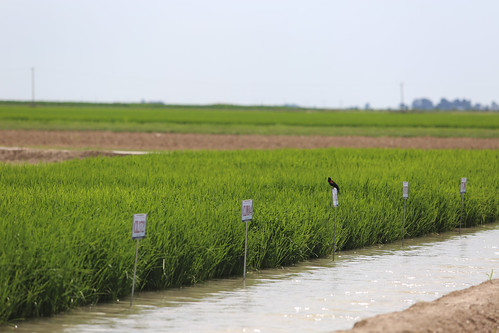Barry could pose a triple threat to Arkansas rice crop already weathering a hard year
July 11, 2019
By Ryan McGeeney
U of A System Division of Agriculture
Fast Facts:
- Tropical Storm Barry expected to dump 4-10 inches across delta
- Additional rain could be detrimental to rice crop
(541 words)
(Newsrooms: With art https://flic.kr/p/2ghp1pN and https://flic.kr/p/2gwAuGJ )
Download Word version
LITTLE ROCK – Arkansas’ rice crop, delayed by a wet spring and bludgeoned by high heat, is now facing a triple threat from Tropical Storm Barry, whose remnants are expected to drop heavy rain on the eastern side of the state on Sunday.

A forecast map issued by the National Hurricane Center on Thursday showed potential rainfall totals ranging from 4 to 10 inches in eastern Arkansas, with the higher amounts expected closer to the Mississippi River. (see: https://www.nhc.noaa.gov/refresh/graphics_at2+shtml/145531.shtml?rainqpf#contents)
“Barry has the potential to dump inches of rain during flowering and heading – rain which will disrupt pollination,” said Jarrod Hardke, extension rice agronomist for the University of Arkansas System Division of Agriculture.

“We’re very vulnerable at this point, particularly as the plants begin flowering,” Hardke said. “A little wind is good — we like to have pollen on the move, because it means improved chances for pollination and grain fill. But if we get excessive winds and heavy rains during this period, particularly during the middle of the day, it’s bad news.
“It’s not that common in July, but you can end up blanking out entire panicles from severe wind and rain,” he said.
The rain presents an additional worry.
“All that moisture will further aid disease development such as sheath blight and blast,” Hardke said.
The third worry is whatever strength Barry still might be packing when he sweeps into Arkansas: “If accompanied by strong winds, the tropical storm can also cause early lodging.”
Lodging is a condition in which the plant’s stalks start to lean or are flattened, which makes the grain difficult to harvest.
Already wet
The National Oceanic and Atmospheric Administration said Tuesday that July 2018 through June 2019 represented the wettest 12 months on record for the 48 contiguous states, with an average rainfall of more than 37.8 inches — 7.9 inches above average. According to the National Weather Service in Little Rock, several cities had more than their share of rain in June. West Memphis saw 186 percent of its normal rainfall, Pine Bluff had 110 percent of its normal rainfall and Little Rock had 123 percent of its normal June rainfall. On the flipside, Jonesboro came in at 91 percent of normal.
“The weather is very much an unknown,” Hardke said. “One of the problems with the sporadic thunderstorms this time of year is that they pop up in the middle of the day, when plants are actively attempting to flower. If a storm hits around 4 p.m., it’s not that big of a deal — most of the flowering for that day is complete. But noon is the worst possible time for a storm to hit rice in this stage.
Aside from storms, growers will also be keeping an eye on nighttime temperatures.
“Once we pass flowering, and get into the grain fill stage, the concern is the night time temperatures getting too high,” Hardke said. “It can lead to chalky rice kernels, rather than translucent. It’s just not as desirable an appearance, although it doesn’t necessarily change how the rice cooks or eats. In extreme cases, it can lead to yield losses.
“This is always a concern this time of year, he said. “But with everything else that’s happened to us this year, I think everyone would agree that we’re all kind of hoping for a pass at some point this season. We’ve gotten hit with about everything possible in one season so far — we’re due to miss one.”
To learn about row crop agriculture in Arkansas, contact your local Cooperative Extension Service agent or visit www.uaex.uada.edu. Follow us on Twitter at @AR_Extension.
About the Division of Agriculture
The University of Arkansas System Division of Agriculture’s mission is to strengthen agriculture, communities, and families by connecting trusted research to the adoption of best practices. Through the Agricultural Experiment Station and the Cooperative Extension Service, the Division of Agriculture conducts research and extension work within the nation’s historic land grant education system.
The Division of Agriculture is one of 20 entities within the University of Arkansas System. It has offices in all 75 counties in Arkansas and faculty on five system campuses.
Pursuant to 7 CFR § 15.3, the University of Arkansas System Division of Agriculture offers all its Extension and Research programs and services (including employment) without regard to race, color, sex, national origin, religion, age, disability, marital or veteran status, genetic information, sexual preference, pregnancy or any other legally protected status, and is an equal opportunity institution.
# # #
Media Contact: Ryan McGeeney
Cooperative Extension Service
(501) 671-2120
rmcgeeney@uada.edu
Related Links